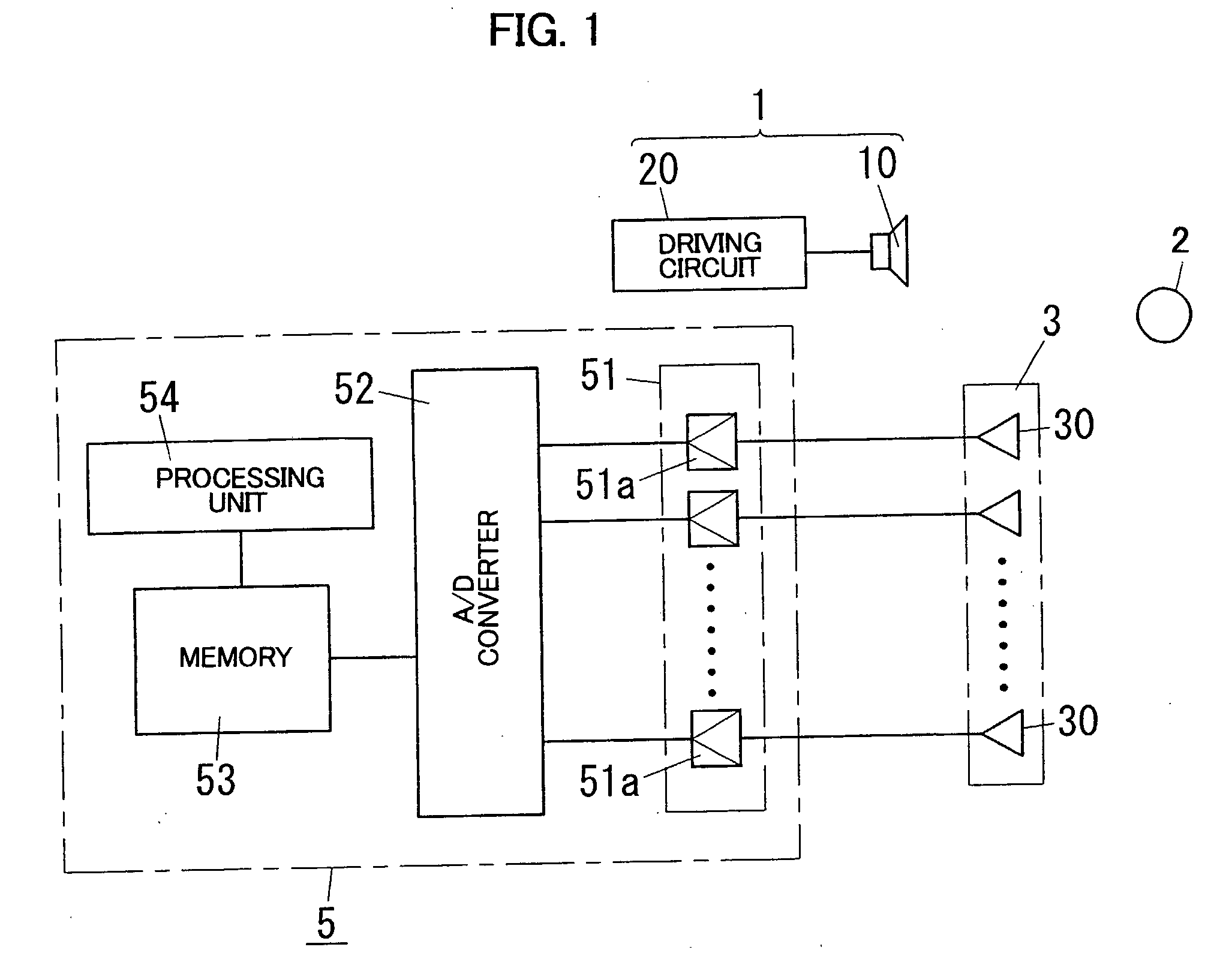Acoustic Wave Sensor
a technology of acoustic waves and sensors, applied in the field of acoustic wave sensors, can solve the problems of inability to detect the distance to an object relative to the wave receiving device, the inability to distinguish between the reflected waves from these two objects on the basis, and the inability to detect the distance to the object with respect to the object positioned within a predetermined distance from the wave receiving device. , to achieve the effect of increasing the angular resolution
- Summary
- Abstract
- Description
- Claims
- Application Information
AI Technical Summary
Benefits of technology
Problems solved by technology
Method used
Image
Examples
first embodiment
[0050]An acoustic wave sensor in accordance with a first embodiment of the present invention is described with reference to figures. The first embodiment relates to the acoustic wave sensor detecting both of a distance to an object and an orientation where the object is located in order to recognize three dimension locus of the object.
[0051]As shown in FIG. 1, the acoustic wave sensor of the first embodiment comprises a wave transmitter 1 for transmitting an acoustic wave (a compressional wave) intermittently in the air, a wave receiver 3 for receiving reflected waves reflected by an object 2, and a signal processing circuit 5 for processing output of the wave receiver 3. The acoustic wave sensor is configured to detect the distance to the object 2 and the orientation where the object 2 is located on the basis of terms from a time when an acoustic wave is transmitted from the wave transmitter 1 to times when the acoustic waves reflected by the object 2 are received by the wave recei...
second embodiment
[0090]Subsequently, an acoustic wave sensor in accordance with a second embodiment of the present invention is described with reference to the figures. The second embodiment relates to the acoustic wave sensor for detecting both of a distance to an object and an orientation where the object is located in order to recognize three dimension locus of the object. Basic configuration of the acoustic wave sensor of the second embodiment is substantially the same as that of the acoustic wave sensor of the first embodiment, but configurations of a wave transmitting device 10 and a driving circuit 20 constituting the wave transmitter 1 are different, as shown in FIG. 9. Therefore, only the difference is explained, and illustration and description of the other configurations are omitted.
[0091]The wave transmitting device 10 in the second embodiment is a thermally induced acoustic wave generator generating an acoustic wave by thermal impact, and has a pair of electrodes 19 opposing with each o...
third embodiment
[0095]Subsequently, an acoustic wave sensor in accordance with a third embodiment of the present invention is described. The third embodiment relates to the acoustic wave sensor for detecting both of a distance to an object and an orientation where the object is located in order to recognize three dimension locus of the object. Basic configuration of the acoustic wave sensor of the third embodiment is substantially the same as that of the acoustic wave sensor of the first embodiment, but configurations of a wave transmitting device 10 and a driving circuit 20 constituting the wave transmitter 1 are different. Therefore, only the difference is explained.
[0096]In a wave transmitter 1 of the third embodiment, a thermally induced acoustic wave generator used as the wave transmitting device 10 comprises a member to be heated having a low heat capacity and a low heat conductance, and a laser device such as a semiconductor laser for heating the member to be heated by irradiation of a laser...
PUM
 Login to View More
Login to View More Abstract
Description
Claims
Application Information
 Login to View More
Login to View More - R&D
- Intellectual Property
- Life Sciences
- Materials
- Tech Scout
- Unparalleled Data Quality
- Higher Quality Content
- 60% Fewer Hallucinations
Browse by: Latest US Patents, China's latest patents, Technical Efficacy Thesaurus, Application Domain, Technology Topic, Popular Technical Reports.
© 2025 PatSnap. All rights reserved.Legal|Privacy policy|Modern Slavery Act Transparency Statement|Sitemap|About US| Contact US: help@patsnap.com



